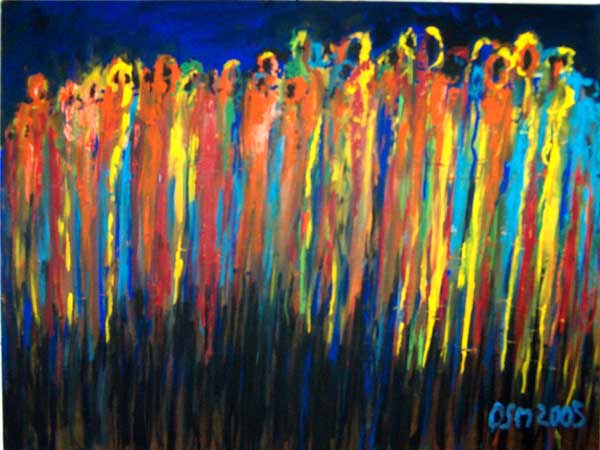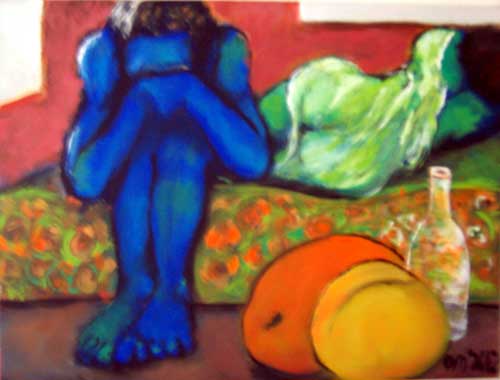Florence Gelo
Rosemary Harris
Philadelphia, Pennsylvania, United States

Mohamed Osman
Acrylic
24” x 36”
Physicians often face practical dilemmas when treating patients from cultures whose belief systems may differ greatly from those underlying Western medicine. Non-Western healing modalities often attempt to integrate the spiritual and physical, and in some instances, traditional healers may be appropriately integrated into patient care. Dr. Harris uses the following “Vodou Viagra” tale to teach medical students and residents about the role an indigenous healing practice played in treating one of her patients. The teaching helps dispel the pejorative myths associated with non-Western healing practices and cultivates appreciation for non-Western perspectives on illness.
In the “pre-HIPPA” and “pre-Viagra” era of a small town in Maryland, Adom, a 42-year-old widower of West African descent, consulted his primary care physician for erectile dysfunction. Adom had none of the typical risk factors for erectile dysfunction, and three separate urologic consults had all diagnosed “psychosexual dysfunction.” When Dr. Harris reviewed the information with Adom and explained to him that there was no physiologic explanation for his problem, he readily agreed that the problem was “in his head.” Although he was skeptical of psychotherapy, he accepted a referral and dutifully “worked on his issues” with the therapist. Therapy was unsuccessful, however, and Adom returned to Dr. Harris, with his condition unimproved. The therapist urged him to share with his primary care doctor the unique circumstances leading to his problem. The problem, he told Dr. Harris, was that an old girlfriend had cursed him.
Several years ago, Adom’s wife, Kisa, had died slowly at home of multiple myeloma, complicated by end-stage renal disease. She refused treatment in the hospital and underwent dialysis at their Maryland home four times a week, with each treatment lasting five hours. Adom cared for her single-handedly and watched her grow sicker and weaker over the course of a year. Meanwhile, he worked nights in a slaughterhouse, pulling the meat off chicken thighs. He would arrive home exhausted and sweaty from heavy labor, only to do all the washing up and tend to his needy, depressed wife, who was often waiting up for him.
Some months prior to his wife’s illness, Adom had planned to leave his wife for another woman. When Kisa became ill, however, Adom told his girlfriend, Kimbry, that he could not leave a sick woman. The girlfriend was not appeased and was unwilling to wait for his wife to die. When Adom refused to leave his wife, Kimbry flew into a rage, screaming, “If I cannot have you, then no one else will . . . now or ever!” She told Adom she had cast “a very powerful spell” on him. Kimbry, who grew up in New Orleans, practiced one of many forms of Vodou that she had learned from her grandmother, mother, and aunt.

Mohamed Osman
Acrylic
30” x 40”
Late at night, transferring dialysis bags for his wife or cleaning items in the laundry tub, Adom would look up into the blackness of his window and see dead male animals strung there, which he described as part of the spell. Squirrels, muskrats, a bat strung on a wire across the windows—even a cat with its head and paws sliced off—were constant reminders that his own male animal was dead.
Adom admitted to Dr. Harris that he was terrified, thinking the spell could be fatal. Despite cognitive therapy to alter this belief, he did not improve. Convinced that it was possible to erase his belief in the spell through deep relaxation, Dr. Harris decided to send Adom to a hypnotherapist. But swapping negative or irrational thoughts with positive, rational ones is not automatic. Adom did not respond to the idea that magic only had power if you believed in it.
Dr. Harris, aware of the existence of “culture-bound syndromes,” surmised that Adom’s understanding of his symptoms was linked to his culture and spiritual beliefs. She asked her nurse Alma, an older woman familiar with the many different types of African-derived rituals practiced in the area, if she knew anyone who practiced witchcraft. Without missing a beat, Alma replied, “He will need the Haitian.” Alma was referring to Haitian Vodou, which emerged in Haiti in the early 16th century via West African slaves, who incorporated elements of their European masters’ beliefs, particularly Roman Catholicism, into their indigenous religious practices. Similarly the Diaspora in Haiti and the US have adapted the stunning array of vastly differing beliefs and practices exhibited in African religious traditions into a variety of belief systems—of which Vodou is just one example to be encountered by a medical practitioner.
Adom met with the Haitian Vodou practitioner, agreed to her intervention, and prepared, according to her instructions, for the counter-spell over several weeks’ time. The folk healer told Adom that by completing these tasks he could regain his “personal power” and return to balance with the world around him. The counter-spell involved chants, prayer, herbal preparations, and roots and was performed over a period of several hours at a set, auspicious time on an autumn night.
In the way of all patients who find relief or cure from their ailments, Adom did not come to Dr. Harris’ office for many months. When he reappeared—radiant and grateful to be healed, with his new girlfriend in tow—they briefly discussed the strength of the counter-spell. Adom believed that his jealous girlfriend had cast a spell, and desperation led him to Dr. Harris, trusting that she would make him well. It is not clear why Adom was more willing to accept the cure of a Haitian Vodou practitioner over a Western therapist. The African continent represents an immeasurable number of unique individual and cultural practices, and not every patient in Adom’s position would have necessarily accepted such a treatment. But in the end, Adom was “cursed” by one practitioner of Vodou and healed by another one, in a tradition going back nearly 6,000 years to West Africa.
Like Adom, each patient enters the exam room with a unique collection of beliefs and values. Dr. Harris uses this case study to teach medical students and residents about the importance of understanding patients’ cultural beliefs in order to establish trust and enhance the treatment process. In school, medical students are taught to ask open-ended questions to identify patients’ beliefs about their illness and their health care, but they are not always asked to think about how to respectfully and artfully incorporate patient belief systems into their treatment. Dr. Harris teaches students to confront their skepticism about indigenous belief systems and to consider that sometimes a witch is better than a urologist.
FLORENCE GELO, DMin, NCPsyA, is an associate professor and the behavioral science coordinator for the Family Medicine Residency Program at Drexel University College of Medicine, where she has established a curriculum around religion, spirituality, and medicine for residents. Gelo is also a pastoral psychotherapist in private practice specializing in grief, loss, and chronic illness.
ROSEMARY HARRIS, MD, is assistant professor in the Department of Family, Community, and Preventive Medicine. Her clinical interests include end-of-life care, HIV, and underserved medicine. She practices in Warminster, Pennsylvania.
About the artist:
MOHAMED BUWE OSMAN, MD, is an American board-certified physician and geriatrician, formerly with Group Health Cooperative, and a former United Nations physician in Africa. He is also a self-taught artist. He credits his early life in Somalia, his medical education in Russia, and his medical experiences in Kenya and Somalia as major influences on his art. His paintings are inspired by traditional African art and capture psychosocial, cultural, and medical concepts that are difficult to express but are philosophically intriguing. His work conveys the mysterious, colorful, and positive energy we are surrounded by in our everyday lives.
His art has been published in several medical and nonmedical journals, including the Medical Journal of Australia and the International Review of African American Art. His website is www.osmanart.net and www.primarycareofstpauls.com.
Highlighted in Frontispiece Winter 2012 – Volume 4, Issue 1

Leave a Reply